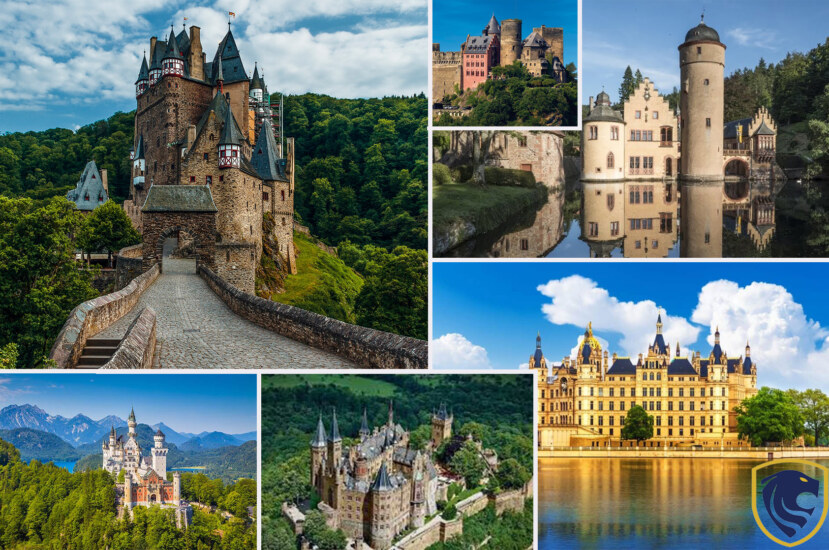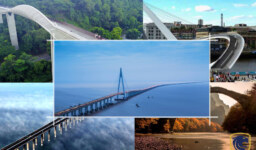In our childhood which was the time we dwelt in fairy tales, we always dreamed about living in a royal castle right? The magnificent castles in Disney cartoons were where we wanted to reside. Although the reality turned out to be a lot different, we still love castles. Today we are going to explore the castles that are situated in the land of Castels; Germany.
01) Nueschwanstein Castle
The greatest castle in Germany and the gem of Europe’s fairytale castles, Neuschwanstein, lies built on the rim of the Alps south of Munich. Neuschwanstein, also known as New Swanstone Castle. Moreover, this is a magnificent castle that Walt Disney utilized as inspiration for the castle in Sleeping Beauty. You’ll see why Disney adored Neuschwanstein right away—from the mountain setting with a lake view to the classic architecture and opulent interior. It’s maybe the finest fairytale castle in the entire world. Not simply one of the best castles to see in Germany.
. Neuschwanstein was established in the late 1800s, but unlike other castles, it was never designed for defense. Instead, Ludwig II of Bavaria built this castle as a fancy getaway. Only 15 of the 200 rooms that were originally intended for the castle were built before Ludwig’s passing in 1886. Yet the term “rooms” scarcely does justice to the scale and opulence of the final halls. In addition to paintings, mosaics, arcades, and carved oak, the Throne Room, Singers’ Hall, Ludwig’s chamber, and other opulent rooms also include these decorative elements.
2) Hohenzollern Castle (Burg Hohenzollern)
One of the most spectacular castles in all of Europe, Hohenzollern Castle is sure to conjure up visions of dragon mythology. Due to its elevated location in the German countryside on a hilltop, the Castle nearly doesn’t appear genuine. On this hilltop, the Prussian Royal family has lived in a residence since 1061 AD. In addition, this is a formal castle since 1267. The Prussian Royal Family has continued to be the castle’s guardians even though its design has evolved through time and even required a complete renovation in 1423. Having the same royal family in charge of a castle estate for such a long time is practically unheard of.
The castle, which is perched atop Mount Hohenzollern, dates back to the 11th century. Only the chapel of the ancient castle remains after decades of destruction. In the middle of the 19th century, King Frederick William IV of Prussia constructed the current castle. The Prince of Prussia and his wife continue to reside at the Hohenzollern today. But they continue to allow visitors access to their picturesque castle.

Nueschwanstein Castle, Hohenzollern Castle, Schwerin Castle
3) Schwerin Castle (Schweriner Schloss)
This enormous castle is located on an island in the center of Schwerin Lake and seems like something out of a fantasy. The third-largest lake in Germany has been home to a fort since Slavic tribes first inhabited the region in 973. It is a notable example of Romantic Historicism in Germany, along with Neuschwanstein, thanks to its onion-domed cupolas, tea caddy tower, and pointed spires. It even goes by the moniker “Neuschwanstein of the North.” The castle subsequently came under the control of the local Dukes as a result of fights between Germanic tribes and noblemen from the picturesque surroundings. The majority of the castle was constructed in the 1500s, considerably enlarging the grounds.
Grand Duke Friedrich Franz II commissioned a total renovation in the middle of the 1800s. He only kept a portion of the original structure from the 16th and 17th centuries. The outcome was the modern castle or palace, which is rather fantastical and underwent extensive preservation when Germany was reunited.
4) Heidelberg Castle (Heidelberger Schloss)
One of the greatest remaining specimens of German Renaissance architecture is the enormous Heidelberg Castle, which is made of red sandstone. It forms a background that can be seen from virtually anywhere in town or along the Neckar River since it has a dominating location on the slope right above Heidelberg’s Old Town, which lies approximately 200 meters below.
The Heidelberg Castle complex’s ruins are quite fascinating. The castle’s construction began in 1196 with the top castle. That was followed in 1212 by the lower castle, which was finished in 1225. The castle’s largest extension took place in 1410 when Holy Roman Emperor Rupert III opted to use it as his residence. The Emperor visited the complex frequently since it was among Germany’s most spectacular. Heidelberg Castle was regarded as one of the finest Renaissance palaces at its height.
The higher Heidelberg Castle was destroyed by fire in 1537 after being hit by lightning. The lower palace escaped the fire, but 150 years later, during the Grand Alliance War, the French besieged it. Although it was repaired, the lower castle was also severely destroyed by fire and lightning in 1764. It seems surreal to explore the Heidelberg Castle’s ruins and surviving structures nowadays.
5) Burg Eltz Castle
Burg Eltz, one of the most magnificent fairy tale castles in the world, is tucked away in a beautiful valley. Since 1157, a single family has owned the site, and the present castle was constructed between 1490 and 1540. Only 3 medieval castles from the Rhine River region have survived the ages without being demolished or completely rebuilt, and Burg Eltz is one of them.
Since its construction in the 12th century, the castle has been owned by the Kempenich family. It has been meticulously preserved and refurbished, with stunning interiors and many of its original furniture. It is among the greatest medieval castle examples in all of Germany.
By the middle of the 1600s, the castle had grown to its current size, with eight tall residential structures surrounding the main courtyard, each with 100 rooms. The 19th century’s meticulous renovation preserved the buildings’ ornamentation.

Heidelberg Castle, Burg Eltz Castle, Burg Frankenstein
6. Burg Frankenstein (Darmstadt, Germany)
This castle, which is now in partial ruin, was constructed for Lord Conrad II Reiz in 1250 and served as the model for Mary Shelley’s novel Frankenstein in 1818. The majority of the mythology was based on Johann Conrad Dippel’s life, who was born there in 1673. Alchemist Dippel established a lab inside. The castle created animal oils that he would sell and advertise as the “elixir of life.” The castle hosted a Halloween celebration for American soldiers during World War 2, and it has since become a yearly occasion. Additionally, the restaurant Frankenstein Castle frequently conducts spooky feasts and Medieval banquets.
7. Nuremberg Imperial Castle (Nürnberg, Germany):
In the Middle Ages, the lofty Nurmeburg Castle served as both the city’s defense and the primary factor in its expansion into a major metropolis. The most significant event occurred in 1356 when Emperor Charles IV decreed that every new Holy Roman Emperor would be required to conduct their first Diet at this fortress (government session). The hamlet of Nurmeburg grew from less than 4,000 to well over 30,000 inhabitants in only one century. Because of the relocation, which transferred a lot of authority to the castle.
8. Mespelbrunn Castle
A late-medieval, early-Renaissance moated fortress constructed in a tributary valley near Mespelbrunn is known as Mespelbrunn Castle. This lovely castle has grown to become one of the most well-known in Germany. It is located in the Spessart forest, halfway between Frankfurt and Würzburg.
The castle rises from a crystal-clear lake, and the hills surrounding it are covered with rich vegetation. The interior of the castle is filled with well-preserved pikes and armor from the 16th century, as well as lovely red sandstone and stained glass windows.

Mespelbrunn Castle, Schönburg Castle, Reichsburg Castle
9) Schönburg Castle
Between 911 and 1166, Schönburg Castle was first attested in writing. The castle was destroyed in 1689 by French troops during the Palatinate Wars and lay in ruins for 200 years until being purchased by a German-American family. Following the family’s restoration, the local council took back control of the castle’s ownership and management before leasing it to a different family a few years later. No matter how long you plan to stay, you really must see the castle gardens. The home features several balconies and endless views of the Rhine Valley.
10) Reichsburg Castle
In the 12th century, between the old Roman city of Trier and the Rhine River, Reichsburg Castle gathered tolls from ships carrying merchandise on the Mosel. Ships were prevented by a detachable chain across the river, despite the castle’s dominating 330-meter height above the river.
The bishops and electors of Trier, who held possession of the fortress from the 14th to the 16th century, made several additions to it as the tolls filled their coffers. The castle and Cochem were in ruins when the French, led by King Louis XIV, stormed the area in 1689. And thus it remained until a businessman from Berlin purchased it and started development in 1868.




